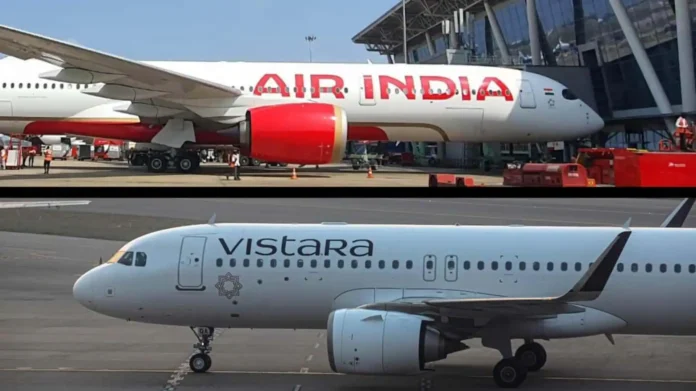In a landmark consolidation for the Indian aviation industry, Tata-owned Air India announced on Tuesday, November 12, 2024, the completion of its merger with Vistara, a move that brings together Tata’s four airline entities into one unified structure. The combined full-service carrier, now operating under the Air India brand with the airline code “AI,” is set to manage over 5,600 weekly flights across 90 destinations globally, enhancing its competitive standing and global reach. This merger, part of Tata Group’s long-term strategic plan called Vihaan.AI, aims to transform Air India into a leading aviation powerhouse with an expansive fleet, more efficient operations, and significantly enhanced passenger connectivity.
A Unified Brand with Expanded Capabilities.
The newly merged entity retains the Air India name, with the Vistara fleet’s flights identified by a four-digit flight number starting with “2” (e.g., Vistara’s former UK 955 will now appear as AI 2955). Following this merger, Air India now controls a formidable fleet of 208 aircraft and has significantly increased its operational capacity. With over 5,600 flights weekly, the carrier reaches more than 90 domestic and international destinations, while Tata’s overall aviation portfolio, including its budget carrier arm Air India Express, spans over 8,300 weekly flights on 312 routes with a 300-aircraft fleet.
The merger marks Tata Group’s second successful airline consolidation in 2024, following the unification of Air India Express with AIX Connect (formerly AirAsia India) in October. This ambitious consolidation aligns with Tata’s broader five-year plan for Vihaan.AI, positioning the group to drive the growth and transformation of India’s aviation sector with both full-service and low-cost airlines under one corporate umbrella.
Loyalty Program Integration and Operational Transition.
In addition to unifying flight operations, Air India has integrated Vistara’s loyalty members into its own revamped frequent flyer program, now rebranded as the Maharaja Club. Over 4.5 million Club Vistara (CV) accounts have been seamlessly migrated to the new Maharaja Club, allowing existing Vistara members to continue enjoying their loyalty benefits within a broader network. Vistara’s previous shareholding partner, Singapore Airlines, which held a 49% stake, has retained a significant 25.1% share in the newly merged Air India, reinforcing its strategic interest in the carrier’s future.
With the aim of streamlining service and customer experience, Air India has undertaken substantial backend transitions, including migrating 270,000 customer bookings, merging more than 4,000 vendor contracts, and inducting over 6,000 Vistara employees into its workforce. According to Campbell Wilson, Air India’s Managing Director & CEO, extensive cross-collaborative efforts were made to ensure a seamless transition for customers, employees, and assets. “The merger of Air India and Vistara completes the consolidation and restructuring phase of the Air India Group’s post-privatisation transformation journey, and is thus a significant milestone,” Wilson commented, underscoring the operational alignment achieved in the last two years.
Long-Term Vision and Strategic Expansion Plans.
Tata Group’s aviation arm has ambitious goals for its new unified brand. Under Vihaan.AI, Air India is set to undergo a $400 million refurbishment for older aircraft interiors, positioning it as a premium, competitive player on the global stage. The group has recently acquired over 500 new aircraft to boost fleet expansion and accommodate projected passenger demand. Furthermore, Tata’s commitment to robust operational infrastructure includes opening a new 600,000-square-foot training facility capable of accommodating 2,000 trainees daily and constructing a 12-bay maintenance base scheduled to open in early 2026.
The operational changes come as part of an industry trend toward greater consolidation, as Air India seeks to achieve scale, efficiency, and enhanced service quality. The airline’s newly expanded network will offer extended connectivity to over 800 global destinations, backed by more than 75 codeshare and interline agreements, thereby providing seamless travel options and broad accessibility for passengers.
While the merger has been celebrated for its streamlined approach to creating a comprehensive national carrier, some industry observers have expressed caution about potential challenges in maintaining service consistency across a rapidly expanding fleet and varied market segments. Air India’s unified structure, which combines luxury service with affordable options through its low-cost arm, will need to balance premium and budget offerings effectively to capture a diverse customer base.

A New Chapter for Indian Aviation.
With the successful completion of this merger, Air India stands poised to become a key player in the global aviation market. The integration of fleet, staff, and loyalty programs, coupled with an extensive route expansion, signifies Tata Group’s commitment to reviving and elevating India’s flag carrier. As the airline embarks on its post-merger journey, it represents a renewed vision of India’s aviation future, one that balances tradition with modernity and innovation with service excellence.

